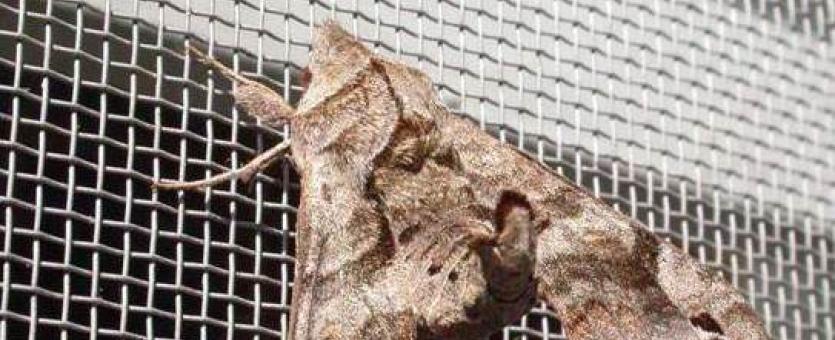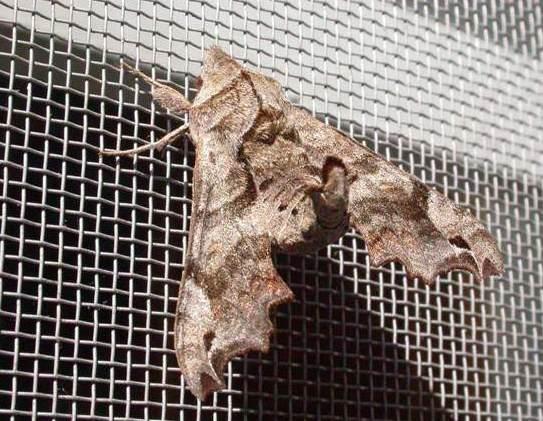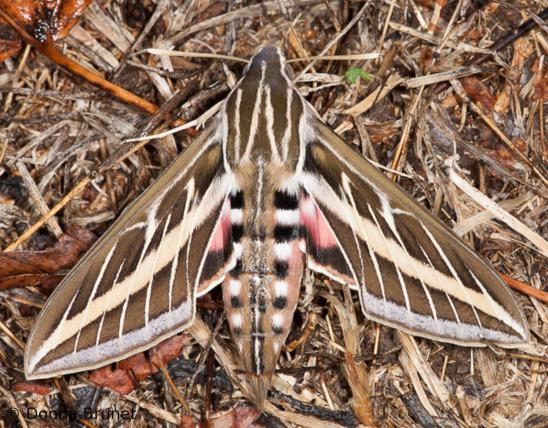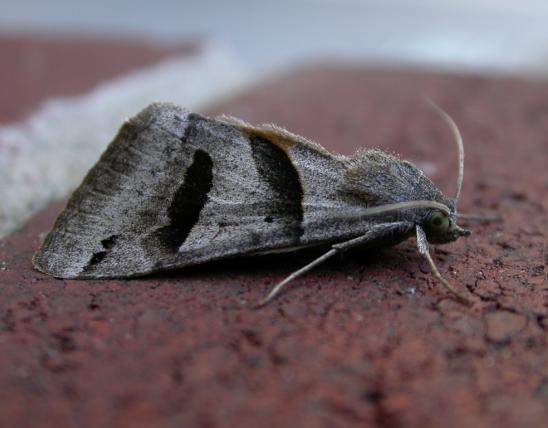
The lettered sphinx is the first of our sphinx moths to emerge in early springtime and may be seen in our state March through July. In addition to its early-season appearance, identification characters include deeply scalloped forewing margins and (in males only) a tendency to curl the abdomen upward. Looking more closely at the wing coloration patterns, note the forewings are overall tan or gray, with dark, parallel banding and a small spot near the wing tip that is half black and half white. The hindwings are rust-colored, fairly plain, with a dark band on the outer margin and usually much fainter band midway across the wing.
The caterpillars, in their later stages, are yellowish green with a yellow or orangish spinelike horn at the hind end; the horn typically curves slightly downward. A yellow stripe runs forward from the base of the horn along both sides along the back. Several oblique (slanted) yellow streaks along the side of the body, passing just under the black spiracles (breathing holes). There are usually numerous fine yellow bands on the top and sides. Younger caterpillars are yellow with a very long black horn that is often yellow-tipped.
Learn more about sphinx moths as a family on their group page.
Wingspan: 1¾–2¾ inches; relatively small compared to other sphinx moths.
Statewide. Occurs throughout most of the eastern United States.
Habitat and Conservation
Like most other moths, adult lettered sphinxes may fly nearly anywhere. However, they will be most common in and near places with abundant food plants. Because their favorite food plants (such as various species of wild grapes and Virginia creeper) are very common in many Missouri habitats, you can expect to see these moths nearly anywhere, including suburban neighborhoods. A key to seeing them is knowing that they appear in springtime, especially in April and May. They are attracted to lights at night and may fly during the day or night.
To find the larvae, look on the leaves of wild grapes, Virginia creeper, and peppervine, in May through July. Lift the leaves to see if they are resting on the undersides. Look for signs of their nibbling: chewed leaves.
Food
As caterpillars, lettered sphinxes eat the foliage of Virginia creeper (Parthenocissus quinquefolia), wild grapes (Vitus spp.), and peppervine (Ampelopsis arborea). These are all members of the grape family.
Adults sustain themselves by drinking nectar from flowers; lilacs and phloxes (typical springtime bloomers) have been mentioned as nectar sources for this species.
Status
Single-brooded resident species.
Life Cycle
There is only one generation per year, and adults may begin to fly very early in spring, often when it's still rather cold (even in the 40 F range). They may fly during the day or night. They are attracted to lights at night. They mate, lay eggs, and expire usually by June or July. Eggs are deposited singly on appropriate food plants. Depending on temperatures and food availability, the young can grow large quite rapidly, potentially progressing from hatched egg to pupation in about 20 days; the caterpillars are found from May through July. They pupate in the soil, just under the surface. They spend the winter as dormant pupae in their burrows. In early spring, the pupae wriggle upward toward the surface just before they emerge as winged adults.
Human Connections
The genus name, Deidamia, comes from a character in Greek mythology who was the daughter of Lycomedes, king of the Greek island of Skyros; she bore a son to Achilles, and they all figured into the lore of the Trojan War. Apparently, most Americans pronounce it "dee-uh-DAY-me-uh" or "dee-uh-DAH-me-uh."
Does this moth look like it's been written on? The species name, inscriptum, means "inscribed" or "written on." Thus the scientific name and the common name ("lettered") both apparently refer to the markings on this moth. Some individuals have more pronounced markings than others.
Ecosystem Connections
This is the only member of its genus.
This is what bird food looks like. The lettered sphinx is one of thousands of species of herbivorous insects that convert the nutrients in plants into a protein-rich form (their own bodies) that can provide nutrition for birds. Their springtime presence is no doubt a boon for the many migratory birds that arrive in our state in April ready to mate, nest, and raise young. Most nesting birds require a diet rich in protein, and insects, such as this moth, are an in-demand meal.
Night-flying insects, including this moth, are also a favorite food of bats. In April and other spring months, Missouri's bats are coming out of hibernation and looking for food.































